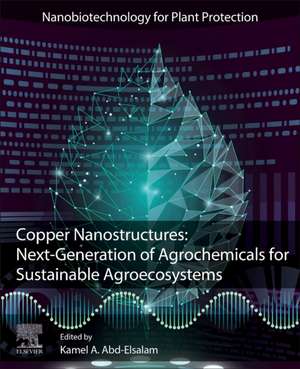Copper Nanostructures: Next-Generation of Agrochemicals for Sustainable Agroecosystems: Nanobiotechnology for Plant Protection
Editat de Kamel A Abd-Elsalamen Limba Engleză Paperback – 19 ian 2022
- Assesses the impact of a large variety of copper-based nanostructures on the agri-food sector
- Discusses how the properties of a variety of copper-based nanomaterials make them effective for agricultural applications
- Explains the challenges surrounding the mass production of copper-based nanomaterials
Preț: 1344.70 lei
Preț vechi: 1755.51 lei
-23% Nou
Puncte Express: 2017
Preț estimativ în valută:
257.37€ • 265.24$ • 217.29£
257.37€ • 265.24$ • 217.29£
Carte tipărită la comandă
Livrare economică 22 februarie-08 martie
Preluare comenzi: 021 569.72.76
Specificații
ISBN-13: 9780128238332
ISBN-10: 012823833X
Pagini: 822
Dimensiuni: 191 x 235 mm
Editura: ELSEVIER SCIENCE
Seria Nanobiotechnology for Plant Protection
ISBN-10: 012823833X
Pagini: 822
Dimensiuni: 191 x 235 mm
Editura: ELSEVIER SCIENCE
Seria Nanobiotechnology for Plant Protection
Cuprins
1. Copper-based nanomaterials: Next-generation agrochemicals: A note from the editor
PART 1 Green synthesis
2. Green synthesis of copper-based nanoparticles using microbes
3. Biosynthesis and characterization methods of copper nanoparticles and their applications in the agricultural sector
4. Natural gums as a sustainable source for synthesizing copper nanoparticles
5. Role of processing parameters in solution routes for controlling size, shape, and morphology of chalcogenide nanoparticles
PART 2 Plant protection
6. Copper-based nanopesticides
7. Cu and Cu-based nanomaterials as nanofungicides
8. Copper-based nanostructures for plant disease management
9. Cu-based nanoparticles as pesticides: Applications and mechanism of management of insect pests
10. Copper nanomaterials for pesticide detection
11. Copper nanomaterials for eliminating the risk of mycotoxins
12. Application of copper-based nanomaterials against parasitic nematodes
PART 3 Plant science
13. Impact of copper-based nanoparticles on economically important plants
14. Copper-based nanoparticles in soil: Uptake, bioaccumulation, toxicity, and biotransformation in plants
15. Nanostructured materials based on copper/carbon as a plant growth stimulant
16. Applications of copper nanoparticles in plant protection and pollution sensing: Toward promoting sustainable agriculture
PART 4 Antimicrobials
17. Biosynthesis and antibacterial activity of Cu and CuO nanoparticles against pathogenic microorganisms
18. Antimicrobial activity of copper nanomaterials: Current status and future perspectives
19. Copper-based nanostructures: Antimicrobial properties against agri-food pathogens
PART 5 Veterinary applications
20. Copper nanoparticles: Synthesis, characterization, and its veterinary applications
21. Safety considerations of copper nanoparticles as food and feed additives
PART 6 Agroecosystem applications
22. Cu-based nanomaterials for production of novel agrochemicals
23. Multifunctional copper-based nanocomposites in agroecosystem applications
24. Effect of copper-based nanoagrochemicals on plants and soil: A critical review
25. Understanding the effect of copper-based nanoagrochemicals on nitrogen-fixation ability of blue-green algae: A review
26. Advances in the applications of copper-based nanocomposites in wastewater treatment
27. Synthesis of copper nanostructures: Antimicrobial applications and environmental remediation of emerging agrochemicals
28. Copper-based metal-organic framework for environmental applications
29. Ecological effects of copper NPs: Advantages and drawbacks regarding current and potential applications
30. Copper nanoparticle-based sensors for environmental pollutions
PART 1 Green synthesis
2. Green synthesis of copper-based nanoparticles using microbes
3. Biosynthesis and characterization methods of copper nanoparticles and their applications in the agricultural sector
4. Natural gums as a sustainable source for synthesizing copper nanoparticles
5. Role of processing parameters in solution routes for controlling size, shape, and morphology of chalcogenide nanoparticles
PART 2 Plant protection
6. Copper-based nanopesticides
7. Cu and Cu-based nanomaterials as nanofungicides
8. Copper-based nanostructures for plant disease management
9. Cu-based nanoparticles as pesticides: Applications and mechanism of management of insect pests
10. Copper nanomaterials for pesticide detection
11. Copper nanomaterials for eliminating the risk of mycotoxins
12. Application of copper-based nanomaterials against parasitic nematodes
PART 3 Plant science
13. Impact of copper-based nanoparticles on economically important plants
14. Copper-based nanoparticles in soil: Uptake, bioaccumulation, toxicity, and biotransformation in plants
15. Nanostructured materials based on copper/carbon as a plant growth stimulant
16. Applications of copper nanoparticles in plant protection and pollution sensing: Toward promoting sustainable agriculture
PART 4 Antimicrobials
17. Biosynthesis and antibacterial activity of Cu and CuO nanoparticles against pathogenic microorganisms
18. Antimicrobial activity of copper nanomaterials: Current status and future perspectives
19. Copper-based nanostructures: Antimicrobial properties against agri-food pathogens
PART 5 Veterinary applications
20. Copper nanoparticles: Synthesis, characterization, and its veterinary applications
21. Safety considerations of copper nanoparticles as food and feed additives
PART 6 Agroecosystem applications
22. Cu-based nanomaterials for production of novel agrochemicals
23. Multifunctional copper-based nanocomposites in agroecosystem applications
24. Effect of copper-based nanoagrochemicals on plants and soil: A critical review
25. Understanding the effect of copper-based nanoagrochemicals on nitrogen-fixation ability of blue-green algae: A review
26. Advances in the applications of copper-based nanocomposites in wastewater treatment
27. Synthesis of copper nanostructures: Antimicrobial applications and environmental remediation of emerging agrochemicals
28. Copper-based metal-organic framework for environmental applications
29. Ecological effects of copper NPs: Advantages and drawbacks regarding current and potential applications
30. Copper nanoparticle-based sensors for environmental pollutions











